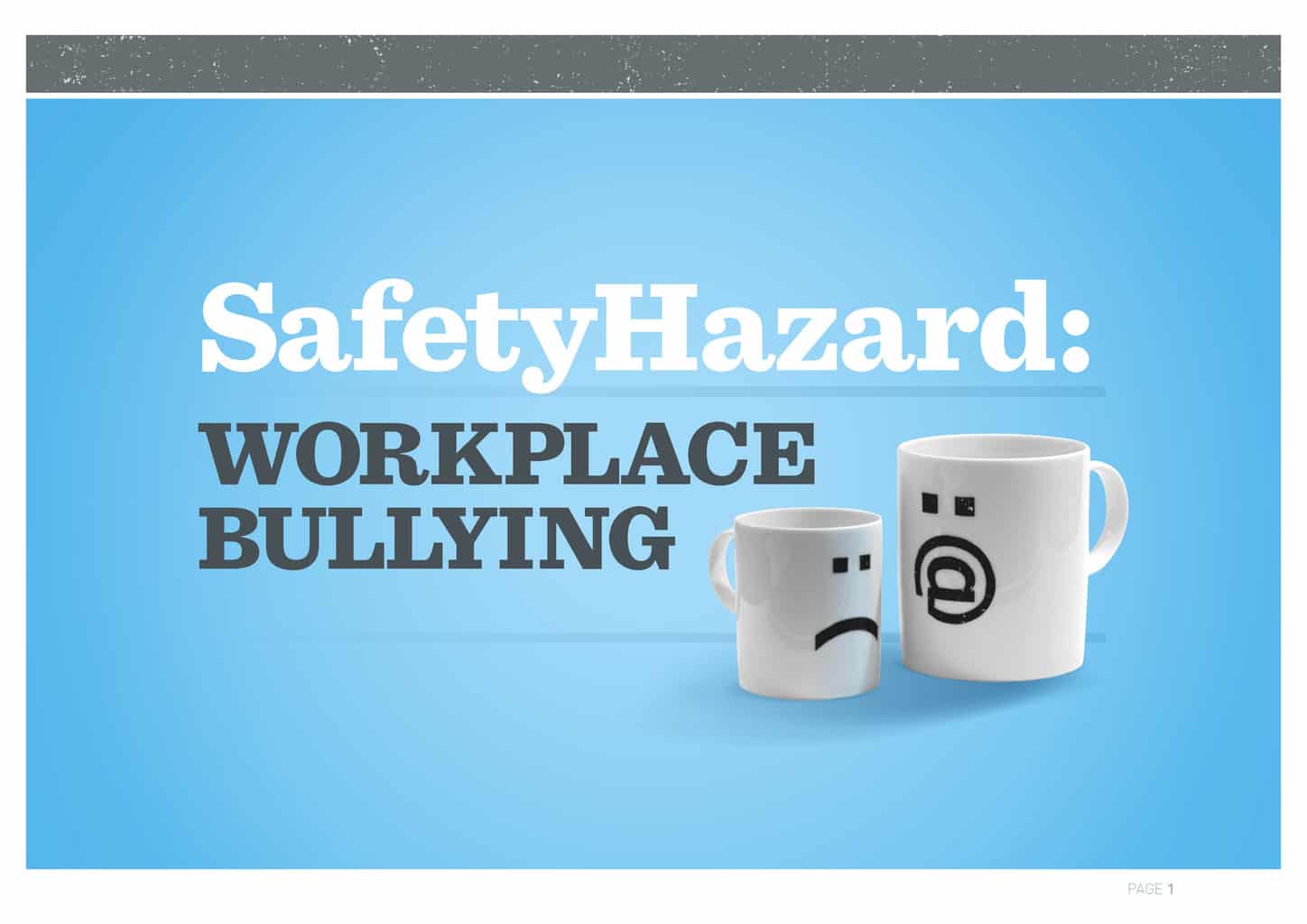In July 2007, I interviewed Michael Licenblat on the issues of workplace stress for the SafetyAtWork podcast. Although the audio quality is not of a professional standard, it is worth revisiting Licenblat’s words as he discusses hours of work, particularly in light of the latest report by the Australian Medical Association on doctors and fatigue.
Category: stress
“Loose” workplace bullying statistics published
Workplace bullying policy matters are at their peak in Australia this week as public hearings occur at the House Standing Committee on Education and Employment inquiry into workplace bullying. Several experts on the prevention of workplace bullying will be appearing at these hearings but the topicality also allows others to release or promote data on workplace bullying.
 Safety Consultants Australia (SCA) released a “blueprint” on Safety Hazard: Workplace Bullying in March 2012 that has been recirculated this week. The blueprint is a useful example of the care that needs to be taken when summarising data on workplace bullying.
Safety Consultants Australia (SCA) released a “blueprint” on Safety Hazard: Workplace Bullying in March 2012 that has been recirculated this week. The blueprint is a useful example of the care that needs to be taken when summarising data on workplace bullying.
SCA states, IN VERY BIG LETTERS, that the Productivity Commission estimated that
“Workplace Bullying costs Australian employers between $6 – $36 billion every year.”
SCA has released a flyer with the same information in EVEN BIGGER LETTERS however the Productivity Commission’s report Performance Benchmarking of Australian Business Regulation: Occupational Health & Safety (2010) states on page 279:
“Estimates of the prevalence and cost of psychosocial hazards vary considerably. For example, using international studies as a guide, estimates of the annual cost of workplace bullying to employers and the economy in Australia ranged from $6 billion to $36 billion (in 2000).” Continue reading ““Loose” workplace bullying statistics published”
Lessons for everyone in the legal action against France Telecom executives over suicides
In 2009-10, SafetyAtWorkBlog followed the unfolding and tragic story of the spate of suicides at France Telecome that were directly related to the change of work practices and organisational policies instigated after privatisation. SafetyAtWorkBlog stated that the suicides could be considered to be a case study of poor personnel management and, in more recent parlance, a failure of safety leadership. This month French authorities have begun investigating France Telecom executives.
According to an AFP report in early July 2012:
“Louis-Pierre Wenes was placed under investigation on Thursday, a day after former France Telecom chief Didier Lombard, for workplace harassment, his lawyer Frederique Beaulieu said.”
At the time of the suicides Wenes was Deputy CEO and Lombard was CEO.
Interestingly and curiously, workplace bullying is not a term used in the France Telecome situation, although it may have met the criteria that Australia applies. Continue reading “Lessons for everyone in the legal action against France Telecom executives over suicides”
Public hearings into Workplace Bullying to commence in Australia
Next week Australia holds public hearings into the issue of workplace bullying. Currently the House Standing Committee on Education and Employment has not yet made any submissions publicly available which handicaps the value of the public hearings for observers but the Trade Unions have released their submissions. Generally, the suggestions for control measures are progressive but the submissions also indicate the extent of the challenge in “controlling” workplace bullying and some of the challenges facing this inquiry.
The ACTU claims that workplace bullying was given national prominence following a survey of union members in 2000 but that survey is not representative of the broader Australian community and should be treated with caution. The ACTU submission seeks support for its survey results from more authoritative sources such as Safe Work Australia and the Productivity Commission. But neither of these sources indicates workplace bullying to be as big an issue as the ACTU claims.
Safe Work Australia’s figures, quoted by the ACTU , say that in
“In 2007/08, 26% of accepted workers compensation claims for mental stress in Australia resulted in 26 or more weeks off work.”
The significance in this quote is that bullying is not mentioned and if one accepts that bullying is a subset of mental stress and psychosocial hazards, bullying should be only a fraction of the 26% figure. It is also the case that it is common for victims of bullying to eliminate the hazard through resignation rather than lodge workers’ compensation claims. So one metric may indicate a low bullying rate but another indicates a “hidden” rate. Accurate measurement, the accumulation of evidence, is a major problem in any study of workplace bullying and is a major challenge for this Parliamentary Inquiry. Continue reading “Public hearings into Workplace Bullying to commence in Australia”
Brodie’s Law not being applied. Perhaps a broader context is needed.
Workplace bullying is a hazard that must be recognized, addressed and punished, but above all prevented. “Brodie’s Law” was always going to be a part of this challenge but never the solution.
 Today’s Age newspaper bemoans the fact that “Brodie’s Law” has not been applied since its introduction 12 months ago. This is not surprising and the article provides some clues to why.
Today’s Age newspaper bemoans the fact that “Brodie’s Law” has not been applied since its introduction 12 months ago. This is not surprising and the article provides some clues to why.
The application of this law seems now to be mainly intended for the Victorian Police force and, as with any police force, there are a great many items on their agenda of which workplace bullying is only one.
Policing and harm prevention
It can also be asked why the Victorian Police force is policing a workplace issue? Workplace safety is principally the responsibility of the employer or, in the new language, person conducting a business or undertaking. The bullies and employer involved in the bullying of Brodie Panlock were prosecuted under occupational health and safety law, not the Crimes Act. Continue reading “Brodie’s Law not being applied. Perhaps a broader context is needed.”
Workplace bullying hits the national agenda in Australia
On Saturday morning, May 26 2012, the Australian Prime Minister, Julia Gillard, and her Workplace Relations Minister, Bill Shorten, announced an inquiry into workplace bullying to be undertaken by the House Standing Committee on Education and Employment and to report to Parliament in November 2012.
 This announcement seems to be another that is buried or overtaken by current political events. The Australian Broadcasting Corporation mentioned workplace bullying as a “silent epidemic”. There is a strong risk that the politicians are overstating the workplace bullying case. WorkSafe Victoria receives thousands of enquiries about workplace bullying but only a portion of them fit the workplace bullying definition and only a handful proceed to a prosecution. The government needs to be careful that it is not operating to a perception of workplace bullying instead of the reality, even though the community outrage is genuinely felt.
This announcement seems to be another that is buried or overtaken by current political events. The Australian Broadcasting Corporation mentioned workplace bullying as a “silent epidemic”. There is a strong risk that the politicians are overstating the workplace bullying case. WorkSafe Victoria receives thousands of enquiries about workplace bullying but only a portion of them fit the workplace bullying definition and only a handful proceed to a prosecution. The government needs to be careful that it is not operating to a perception of workplace bullying instead of the reality, even though the community outrage is genuinely felt.
The Age newspaper and AAP, basically printed an edited media release but the most significant statements have not been printed. These are the comments by the Prime Minister, Minister Shorten and the parents of Brodie Panlock, Damian and Rae. Below is a selection or statements from the doorstop transcript:
PM : “I’ve have had the opportunity to have a conversation with Damian and with Rae about their family experience and they will talk about that family experience themselves, but it led to the loss of their daughter Brodie. And they fought hard here in Victoria for Brodie’s law, to have a law that deals with serious bullying at work. Continue reading “Workplace bullying hits the national agenda in Australia”
Workplace safety and the human condition
Articles and reports about decent work, dignity at work and mental health issues are increasingly appearing on my desktop. Perhaps this indicates a convergence of perspectives to a better understanding of the human imperative in the modern workplace. It may be a realisation of where and how work fits the human condition.
On May 1 2012, the Australian Catholic Social Justice Council (ACSJC) issued a pastoral letter on the “Dignity of Work“. This came across my desk around the same time as I was looking at values-based safety. The parallels between dignity and values-based safety were obvious.
Continue reading “Workplace safety and the human condition”
